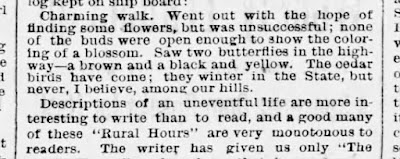True Lover's Knot & Poke Berries by Becky Collis.
You get two similar blocks this month.
Two patterns this month, one with leaves & a floral and one with berries. You'll need 13 blocks if you follow the "official set," on point. Or if you put the blocks side by side on the square and only need 12 you can stitch your favorite of these two.
True Lover's Knot & Poke Berries
Remembering Susan Fenimore Cooper
Susan Augusta Fenimore Cooper (1813 - 1894)
a "naturalist"
Fenimore Art Museum Collection
Susan's grandmother Elizabeth Fenimore Cooper (1751-1817)
with her sewing, a servant and an indoor nursery of botanical projects
probably at Otsego Hall.
The Family Home Otsego Hall
Samuel F. B. Morse, artist and inventor, assisted friend
James Fenimore Cooper in remodeling his parents' house about 1830.
Becky Brown's True Lover's Knot
And her Poke Berries. These go in opposite corners of the quilt in the official set.
See a post about the "Official Set" here. Scroll down:
In 1851 she was the anonymous "lady" who published
Rural Hours, a meditation on nature illustrated with her paintings of
birds and botany. The nature book was her second; the first a novel.
"The following notes contain, in a journal form, the simple record of those little events which make up the course of the seasons in rural life, and were commenced two years since, in the spring of 1848, for the writer's amusement."In her thirties then Susan was a single woman living with younger sister Anne Charlotte (1817-1885) and her parents, who died within weeks of each other soon after the book was published. More loss: Otsego Hall burned in 1853.
Byberry Cottage still stands
She and Charlotte commissioned a smaller house on River Street, constructed from the rubble, where they lived the rest of their lives joined by their widowed sisters as time went on.
Susan published many books and articles over the years, dying at the age of 81 of "apoplexy," a stroke, in 1894. Her Rural Hours is considered one of the early appreciations of nature and its fragility, especially notable in that it was written by a woman.
Rural Hours was preprinted several times. Not everyone was
a fan. Above an 1887 review in the Boston Evening Transcript.
The Blocks
Blocks based on an open wreath from the sampler
in the collection of the Shelburne Museum
Five of the 8 samplers feature similar open wreaths with leaves.
And six show the same structure with berries, red poke berries.
Poke Berries by Denniele Bohannon
True Lover's Knot by Denniele Bohannon
German illustration from 1796.
Einbeere implies one berry, true love.
Are we quibbling here to note that the quadrifolia means four leaves and petals? Whether our quilt pattern designer paid attention to the number of red petals, the way the root is shown above seems to have had some influence on the applique design.
An 1818 botanical painting from Barton's Vegetable Material Medica
showing the poke berry, the flower and the leaf. You may be familiar with
poke plants as they are a hardy American weed.
The berries hang down as in the Shelburne Museum's quilt.
See a post about poke weed symbolizing the 1845 Presidential
campaign of James K. Polk here:
The sampler quilt recorded in the New York project, attributed to Florence
Thompson Strutz, has some romance added with a pair of love birds,
rings and a heart (although it could be the Odd Fellows lodge symbols.)
Go back to Block #1 and see some birds and heart patterns you could add.
Looking for shortcuts I got 8b the Pokeberries done.
Pieced in an oval print.
Robyn Graff's five-sided Poke Berries, top right.
Becky Brown's 9 blocks 1 to 8a & 8b.


















































